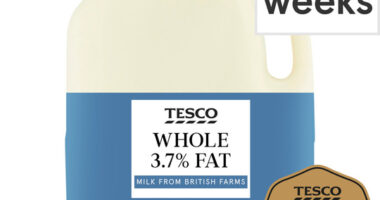
Rising interest rates have enabled pension annuities – once reviled by almost everyone – to make the biggest comeback since Lazarus. The attractive income they now offer people looking to use their pension pot to finance their retirement means they are back on many retirees’ shopping lists.
The maths is compelling. Ten years ago, you could purchase a pension annuity that would pay a guaranteed annual lifetime income of 4 per cent. In other words, for every £100,000 of pension fund converted into an annuity, a retiree would secure an annual income (paid monthly) of £4,000.
Today, primarily as a result of soaring interest rates and higher bond yields, buyers of annuities can lock into lifetime income of 7 per cent.
According to wealth manager Evelyn Partners, a 65-year-old with a £100,000 pension pot can now purchase an annuity that pays an annual income of £7,144. If this person then went on to enjoy a 20-year retirement, they would have paid £100,000 for a lifetime income of £142,880.
Experts say the income now on offer from new annuity purchases compares to that available before the 2008 financial crisis – a cataclysm that heralded an era of low interest rates and brought about the near death of the annuity market.
Henrietta Grimston is associate director at Evelyn Partners. She says the coming months will ‘present an attractive buying opportunity for those looking for the security of guaranteed pension income that annuities provide’.
Mark Ormston, a director of annuity specialist Retirement Line, says it is not inconceivable that annuity rates will jump to 10 per cent if, as widely predicted, the Bank of England base rate rises to 5.5 per cent in the coming months.
Yet Billy Burrows, an annuity expert and founder of the Retirement Planning Project, is more cautious about the future direction of annuity rates.
He says: ‘Annuity rates are currently great value. With signs that inflation is being brought back under control, it is unlikely that bond yields and annuity rates will increase much further. So, now could turn out to be a good time to purchase an annuity.’
Annuities can be bought by people who have a pension fund set up on a defined contribution (or money purchase) basis. Such arrangements are now commonplace.
Sales figures indicate that annuities are now firmly back on the radar of many retirees. According to the Association of British Insurers, annuity sales rose 22 per cent in the first three months of this year as savers scrambled for financial security in retirement.
The amount of pension fund money used to secure these annuities was £1.2 billion. This is the highest quarterly figure since 2015 when the Coalition Government introduced measures designed to give retirees greater choice over how to use their pension pot to fund their future lifestyle.
These measures, dubbed ‘pension freedoms’, were designed in part to provide retirees with options other than the straitjacket of an annuity.
Since the then Chancellor of the Exchequer George Osborne introduced these rules, retirees with defined contribution pension pots have been able to access them as they please – subject to tax being paid on sums above the tax-free cash that they are eligible to withdraw, which is usually 25 per cent of the pension pot’s value.
Lorna Shah is a managing director at insurer Legal & General. She says: ‘Annuities give you a guaranteed income for the rest of your life, irrespective of what happens to interest rates or events in the wider world. They are a good option for people who want peace of mind and the assurance that comes with a guaranteed lifetime income.’ Yet there are drawbacks. Although the previous examples show how well people could do if they purchase an annuity now and then live for another 20 years, not everyone lives so long.
For these people, annuities represent poor value for money – although policies can be set up on a joint life basis, meaning they continue to pay an income (albeit reduced) to the surviving spouse.
When taking out an annuity, the buyer can choose a beneficiary to go on receiving their income, although this is more expensive.
Also, the examples quoted are for ‘flat’ annuity incomes. If you want an income that rises regularly to combat inflation, it will cost a lot more. The same £100,000 would buy you just £5,086 of annual income rising at 3 per cent a year.
Is pension drawdown a better option?
Although annuities are back in favour, they will not be everybody’s cup of tea.
‘Drawdown’ is an alternative way of using a pension pot to fund retirement. Here, the pension fund remains invested, with any cash withdrawals funded by the sale of some of the pot’s assets.
Such an arrangement gives you control over how and when you receive income from your pension. For example, it allows you to make withdrawals to cover big ticket items such as home improvements or the purchase of a new car. Drawdown also means the value of your pension pot has the potential to keep growing, although equally it could fall if stock markets take a turn for the worse. You can also leave the fund to loved ones in your will, a benefit not afforded to annuity plan holders.
Anyone opting for drawdown needs to be aware that fees can eat into the fund’s value. Another risk is that retirees may end up under-utilising their pension fund because of being scared it will run out.
One clever approach is to use some of your pension savings to buy an annuity, leaving the rest in drawdown. Those already in drawdown can use their remaining fund to purchase an annuity, taking advantage of the higher rates.


Good times: Those opting for the annuity route must shop around for the best value plan
Shop around for the best annuity quote
Those opting for the annuity route must shop around for the best value plan. Analysis conducted last week by retirement specialist Age Partnership for The Mail on Sunday shows that for a 65-year-old in good health, the difference between the best and worst annuity available is huge – equivalent to £550 a year on an annuity purchase of £100,000.
Samantha Patterson, Age Partnership’s head of retirement guidance and customer engagement, says: ‘It’s an incredible time for annuity customers. Rates are up and more providers are entering the market, bringing greater choice and competition.’
Annuity rates vary according to age and health. The older you are when you buy, the better the rate you should get. Also, those in poor health or who have a history of smoking should benefit from better paying annuities.
For example, Canada Life is offering an annuity rate of 7.77 per cent to smokers with a high body mass index (£7,770 a year on a £100,000 annuity purchase).
Meanwhile, Just is prepared to pay 8.72 per cent to someone who has either had a heart attack or who lives with diabetes (£8,720 a year).
Will I have to pay tax on my annuity?
Annuities are not tax-free, so you may be liable to pay tax if your total retirement income exceeds the tax-free personal allowance. So if the money from your annuity and other sources of income such as the state pension exceeds £12,571 a year, then you will pay income tax.
On income of £12,571 to £50,270 a year, you are taxed at 20 per cent. For earnings between £50,271 and £125,140 the rate is 40 per cent.
There are exemptions. For example, if you buy an annuity that guarantees to pay out for a set number of years and you die before that ends, tax might not be an issue.
Here, if you die before age 75 and the remaining income under the guarantee goes to a loved one, they will not have to pay tax on it. But if you die aged 75 or older, your loved one will have to pay income tax.










